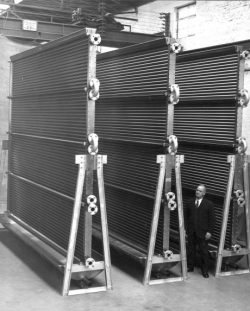Heat exchangers and other components
In the first decades since the foundation of Schmidt, the company mainly produced sprinkling coolers for beer, milk or other liquid foods. Over the years, the production range was enhanced by pumps, spiral-, tube in tube- and shell and tube heat exchangers for the food industry.
In the thirties of the last century, the product range was expanded by the SIGMA plate heat exchangers.
Our intensive colaboration with universities and academies constantly brings in actual know how in the technologies of fluid mechanics, thermodynamics, process engineering and industrial engineering. All this contributes to our new product developments.
The variety of the material processed includes ordinary steels, stainless steels in all qualities, nickel- and titanium alloys as well as cutting-edge gaskets, for example PTFE coated elastomer gaskets.

Today SIGMA plate heat exchangers in gasketed design are used in almost every industry. The foundation of this success are not only the optimized plate patterns, but also the improvements in gasket technology. Throug the variety of gasket materials SIGMA plate heat exchangers today can be used at operating parameters of more than 200°C and operating pressures of 25 barg.
Close cooperation with the Czech company TENEZ A.S. added the SIGMAWIG series in 1991. These gasket free, completely welded plate heat exhangers are the result of the joint experience in plate heat exchanger technology and welding practice for decades. The SIGMAWIG heat exchangers once more expand the operating limits for temperatures and pressure in a significant way.
The wide range of SIGMA plate heat exchangers in size and available plate patterns set the benchmark in plate heat exchanger technology worldwide.
Systems and mechanical engineering
The roots of the mechanical engineering at Schmidt-Bretten can be found in the very early effort to build functional units for the food industry.
The customer – primarily dairies and juice producers – prefered functional units consisting of plate heat exchangers and additional processing components. This lead to heat exchangers with enhancements at the frame to provide additional functions or small control units. Later on such units have been used in the juice industry to avoid an oxidation of the juices during the pasteurization process.
In 1960 Schmidt showed the first plate evaporator SIGMA 35/55 V for the production of concentrates. These units had additional control units for a semi-automatic process management. They were successfully used in the dairy and juice industry.
In the seventies, Schmidt developed desulfiting units for the purpose of extracting sulfur from grape juice. Sulfities are added to grape juice for preservation. Grape juice is required to sweeten wines which could otherwise be too sour for drinking.
In the beginning of the 1980-ies, Schmidt introduced the SIGMASTAR 45 / 90 V. Since then a very successful new generation of plate evaporators. The innovative pattern and structure of the evaporator plates was ground braking in many areas of application. Designed as a climbing film evaporator, the SIGMASTARs for the first time allowed the treatment of highly viscous products as concentrated purres or malt extracts up to 80 % dry substance.
At the end of the eighties Schmidt developed the first dealcoholzation plant for beer and wine. This unique technology has been improved in a way, that today beers can be dealcoholized to a remaining alcohol level of 0.005 Vol. %. And the process allows a complete retention of the flavours.
The precise fulfillment of the customer requirements determins our developments. In our laboratories we are designing the heat exchangers of the future .
The SIGMASTAR 150 V is one of the results. Since 2004 this enhancement of the SIGMASTAR technology enables our custormers to run thermal processes on the highest level of quality combined with a high throughput of fluids.

SIGMASTAR 150 V plate evaporator (2004)
